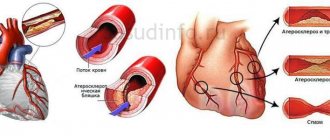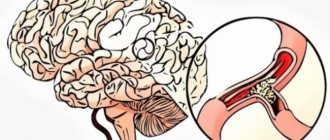Venous discirculation of the brain is the most common type of circulatory disorders in the vessels of the brain. This pathology is actually one of the most common problems in neurological practice.
Short-term, non-severe cerebrovascular accidents can occur without serious consequences for health, however, chronic or acute disruption of blood flow in the cerebral vessels is fraught with the development of strokes, vascular dementia, progressive encephalopathy, and movement disorders.
Dysfunction of blood outflow, which actually lies under the name venous discirculation, contrary to the opinion of many, does not really depend on age. According to statistics, every second person after thirty years of age experiences circulatory disorders to one degree or another.
Development mechanism
Understanding what exactly provokes venous discirculation is not always easy. There can be many reasons. In total, there are three key factors that are involved in pathogenesis.
Among them:
- Mechanical compression. The vessels are compressed, venous outflow is difficult, this means that blood cannot move through them normally, and the result is a rapid progression of organic changes.
When it comes to the brain, the main type of mechanical obstruction is a neoplasm. Cyst or tumor.
It is also possible to localize the root cause in the neck area. In this case, there is compression of the vessels by osteophytes (bone outgrowths), hernias or displaced vertebrae, usually on one side, which causes an asymmetry of the venous outflow.
- The second possible reason is a hormonal factor. It is relatively rare. It is observed as a result of physical overload, severe stress or psycho-emotional stress.
The main substances are cortisol, adrenaline and others. There is also an increase in pressure in the veins and arteries, which disrupts the rate of blood outflow.
- Finally, a significant factor in the development of the disease is a change in the rheological properties of the blood. First of all, its fluidity. The intensity of movement of liquid tissue decreases. It is possible to change the further scheme only with the use of medications and timely treatment.
There are some other mechanisms, but the essence always remains the same: the outflow of venous blood is hampered, and the quality of nutrition of cerebral structures decreases.
Hence the neurological deficit, which is manifested by symptoms characteristic of encephalopathy, a transient ischemic attack. In a word - chronic malnutrition of the brain.
In the absence of therapy, progression is rapid. It takes from a couple of months to several years for dangerous complications to develop. Depends on many factors.
Attention:
The average duration before the onset of a stroke is about 3-5 years, give or take, this is an average figure.
Venous discirculation - what is it?
Venous discirculation (venous dyshemia) is a circulatory disorder in the cerebral vessels associated with a slowdown in venous outflow.
Venous discirculation of the brain is accompanied by a decrease in the rate of blood outflow (more than 4 times) and the development of stagnation of venous blood, leading to oxygen starvation in the brain tissue.
In numbers, in a healthy person the speed of blood movement through the circulatory system is about 220 mm/min, and in a person suffering from dyscirculation it is only about 47 mm/min. Because of this slowdown, the supply of oxygen to brain cells, that is, the main food product, decreases. The cells begin to starve, which has a bad effect on their vital functions.
The symptoms of venous discirculation depend on the severity and duration of cerebral ischemia.
It should be noted that short-term venous discirculation, which does not lead to serious health consequences, can develop in any person with sudden turns of the head, prolonged coughing, or physical exertion.
For reference. Severe and chronic venous discirculation can lead to irreversible changes in brain tissue, manifested in the form of progressive encephalopathies and dementia.
At the same time, in the early stages, cerebral ischemia associated with venous discirculation often responds well to treatment.
Treatment of venous discirculation should be carried out by a neurologist. Self-medication is unacceptable and can lead to serious health consequences.
Classification
The pathological process can be divided according to the severity of the clinical picture and course. This is an integral, unifying method of typing; it should also be called staging of the disease.
Based on the system of characteristics, the following forms are called:
- First stage. As a rule, it occurs without pronounced manifestations. The silent phase of the pathological process. It is detected at this moment only by chance, because the symptomatic complex is scanty or absent altogether. Main problem. Only at such a moment can you completely eliminate organic disorders, restore blood flow and get rid of the problem. As it progresses, this is no longer possible.
- Second stage. The symptoms are obvious. The person still retains the ability to work and can take care of himself in everyday life, but great difficulties arise. You may need outside help. Without treatment, disruption of the cerebral venous outflow rapidly progresses. Structural changes are visible using imaging methods.
- Third stage. Accompanied by severe neurological abnormalities. Hemodynamics are significantly worse than they should be. Urgent medical attention is required. Unfortunately, at this stage it will no longer be possible to radically restore the patient’s original or at least acceptable condition. The only goal is partial improvement, as much as possible. The outcome is a stroke or other dangerous complications.
Staging is carried out based on the results of instrumental studies. The basic techniques are determined by the situation.
Diagnosis and treatment of venous dyshemia
Treatment of this problem can be considered only after the cause of its occurrence has been established, since it is a consequence of some disease or other influencing factor - it is of a secondary nature. The diagnosis made by the doctor usually indicates the location of the VD and the disease that caused it. If the disease, of course, was known at the time of diagnosis.
Sometimes it is not so difficult to determine the cause of VD, but in most cases a thorough examination is required. With the current development of medicine, there is modern equipment that greatly facilitates this process. One of the most successful and accessible methods is Doppler ultrasound (USD). Also, among the most effective methods for diagnosing this phenomenon, in addition to ultrasound, are angiography (using X-rays) and magnetic resonance angiography.
Treatment of venous dyshemia after identifying its causes is carried out in various ways. This can be laser-LED therapy, various types of electrical stimulation, surgery, medications, as well as massage, herbal medicine, traction (muscle stretching), automobilization (muscle relaxation), etc. Most causes require long-term and serious treatment, if possible.
You can see how far science has come in the treatment of vein diseases in the article on varicose veins, where many treatment methods are briefly and clearly described.
Venous dyshemia (VD) is the presence of problems with the flow of blood from the central nervous system (CNS) back to the heart as a result of venous abnormalities, resulting in a slowing of the rate of blood flow through the central nervous system or a change in its direction. Blood flow disorders can be caused by various reasons, for example, diseases of the vascular system, consequences of injuries, muscle spasms, venous insufficiency, tumor, congenital or acquired problems with the spine and others.
To learn more about VD, you should consider concepts such as “chronic spinal venous insufficiency” and “cerebral venous insufficiency”. In most cases, when diagnosed, they are the same as venous dysgemia.
Such articles, on the one hand, are good, but on the other hand, they are bad: the good thing is that anyone can find information on this issue if they are interested, but the bad thing is that some self-medication fanatics will think that they already know everything, and will begin to treat themselves. Too many symptoms coincide in completely different diseases, so it is best to contact a specialist with all questions.
As Russian Radio says: “Medicine is developing so quickly that health cannot keep up with it.”
I really thought that it is important that on every health website there is an inscription at the bottom that you should not self-medicate. Then the author's conscience will be clearer. Unfortunately, such an inscription will not save you from fanatics
I respect traditional medicine and healers who know how to use it. I classify as fanatics those who try to cure without completely understanding what they are actually doing, but simply play their own record, which, moreover, is not even theirs, but borrowed from somewhere. Nature is very wise and logical, but not many people can understand this
Unfortunately, such an inscription will not save you from fanatics. I respect traditional medicine and healers who know how to use it. I classify as fanatics those who try to cure without completely understanding what they are actually doing, but simply play their own record, which, moreover, is not even theirs, but borrowed from somewhere. Nature is very wise and logical, but not many people can understand this.
Yes, that’s probably why they don’t write such an inscription anywhere. You are a very competent person, I completely agree with you.
It’s good when they write the right articles, because until you understand your problem yourself, no doctor will help you. Unfortunately the reality is...
Symptoms of the first stage
At the first stage, when discirculation is just beginning, there is no symptomatic complex at all, or the list of disorders is so small that it has no characteristic features. It is possible to develop a minimal list of manifestations.
Among them:
- Mild episodic headache. Sluggish, makes itself felt intermittently. Absent most of the time.
- Weakness, constant desire to sleep, regardless of the amount of rest per day. This is the most typical sign of venous discirculation of the brain, which is caused by adaptation mechanisms against the background of a reduced volume of nutrition.
- Occasional fainting is rare. Or conditions preceding syncopation.
The first stage lasts up to several years. It is possible to identify it, but only if you look for it purposefully.
That is, diagnosing a disorder at the initial stage is a matter of chance. We are talking about great luck, because there is every chance of restoring the normal state of affairs and completely eradicating the disease.
Second phase
Already much more dangerous. The clinic of stagnation of venous blood is pronounced, accompanied by a group of ghosts:
- Headache. Intense. Continues for several hours, then spontaneously subsides and disappears. The nature of the unpleasant sensation is pressing, bursting. Accompanied by a group of other signs. The manifestation is especially noticeable in the morning, also in the evening, after heavy emotional, mental stress, visual tension and other negative stress factors affecting the state of the body.
- Cyanosis of the nasolabial triangle, facial skin. Not always. The symptom appears at a moment of nervous tension.
- Numbness of fingers, toes. Dermal cover. Feels like tingling, decreased sensitivity. Temporary disturbances in motor activity are possible.
- Paresthesias are intermittent and paroxysmal. The intensity is maximum at the peak of the attack.
- Tinnitus. It develops against the background of a decrease in the quality of blood flow in the brain. It intensifies when changing the position of the body in space.
- Flashing spots in the eyes, decreased visual acuity, photopsia or sharp flashes of light (in fact, these are the simplest hallucinations against the background of irritation of the cerebral cortex, especially the occipital lobe).
- Dizziness. Accompanied by impaired coordination and motor activity. The patient also loses the ability to move normally, and his gait is unsteady.
Signs do not always develop; there is generally a connection with a trigger factor: overwork, a sharp change in ambient temperature, and other factors.
Third stage
Accompanied by pronounced changes in well-being. Neurological deficits reach a peak and precede stroke.
And if the first signs of venous discirculation are not noticeable either to the person himself or often to doctors, everything is obvious here.
- Behavioral disorders. The sufferer becomes apathetic. Depressed, reacts sluggishly to surrounding stimuli and external irritants. This condition turns out to be prevalent, and the patient is almost always in this condition.
- Cognitive dysfunction. It manifests itself as a decrease in memory, speed of thinking, and attention. It is impossible to solve applied problems. Psychological tests are resolved at first at a slower rate, and then cease to be performed at all, because the mental sphere suffers significantly.
- Instead of sensory disturbances in the limbs, paresis and even complete paralysis of the arms/legs occur, depending on the situation. This is an alarming sign indicating structural changes in the brain, irreversible disorders.
- Speech problems. She becomes inarticulate. The reason lies in the mechanical factor. More dangerous options are also possible, for example, aphasia associated with destruction of Wernicke’s, Broca’s areas, temporal or frontal lobes.
- Changes in coordination and orientation in space. It even gets to the point where the patient is unable to move independently, falls, and does not understand his own body and how to control it. A typical sign of destruction of the extrapyramidal system, in particular the cerebellum. The frontal lobe is also affected.
Cerebral venous dyscirculation is accompanied by focal neurological symptoms most of the time, the signs are almost always identical. Only the list and severity of manifestations differ.
A special, isolated case is venous discirculation in the VBB (vertebrobasilar region). It is localized in the neck and occipital lobe of the brain.
Disruption of nutrition and outflow in these structures leads mainly to damage to the occipital lobe and extrapyramidal system. Vision and motor activity suffer.
In severe cases, irreversible eye damage is possible and even probable. A stroke can lead to complete blindness; such situations often occur in clinical practice.
The prospects for restoring visual function are more than vague. Therefore, you should not take it to the limit; you should immediately consult a doctor.
Venous discirculation in children
Unfortunately, venous dysfunction also occurs in children. Most often this is a consequence of poor heredity. If a problem exists, it can be detected already at the breastfeeding stage. Over time, the situation will only get worse.
In addition to heredity, the reasons for the development of cerebral venous dyshemia can be:
- obesity (do not get carried away with fast food systems, which are very attractive to children),
- the possible appearance of a tumor somewhere in the child’s body,
- disruptions in the endocrine system.
Symptoms of venous dyscirculation in children can manifest as frequent fainting, impaired coordination of movements, numbness of the limbs, decreased vision, nosebleeds, frequent causeless increases in body temperature, periodic chills, frequent changes in blood pressure, speech impairment, memory loss, and emotional disturbances.
Attention. A clear manifestation of dysgemia will occur when the veins are blocked by 50% or more.
Parents will have a more difficult time at an age when the child has not yet learned to speak. At this age, you need to be especially attentive to changes in the child’s behavior. For example, he sleeps poorly or cries constantly. Why? Be sure to see a doctor.
Causes
Factors in the development of the pathological process are diverse and complex. Doctors know them quite well; diagnostic tasks include identifying provoking moments that are associated with the onset of the disorder.
- Arterial hypertension. Stable or periodic increase in pressure. The numbers are different. A drop in blood pressure levels has the same negative effect. In both cases, there is a change in the tone of all blood vessels, and the nutrition of the cerebral structures is poor.
- Cardiac (heart) failure. Regardless of phase. Stages 2-3 are especially difficult. The reason lies in the low contractility of the myocardium and the inability to provide adequate nutrition to brain tissue. Read more about chronic heart failure in this article.
- Tumors of cerebral structures. As stated earlier. Cysts, directly solid neoplasms. They compress tissues, provoke an increase in intracranial pressure and worsen venous outflow.
- Osteochondrosis of the cervical spine. A common reason.
- Endocrine diseases. From excess production of thyroid hormones to problems with the adrenal glands, pituitary gland and other structures. Also, the reason becomes relevant at peak moments: puberty, pregnancy, attenuation of the reproductive system (menopause).
- Traumatic brain injuries. Especially when hematomas form.
- Blood diseases, blood flow disorders.
The list of problems is wide. Patients who smoke, regularly consume alcohol, caffeine-based drinks, and people with little physical activity are at risk.
The issue is resolved within the framework of prevention, primary and secondary.
Symptoms of impaired venous outflow from the brain
A diagnosis with this name does not exist in reference books, but it is meant when they talk about chronic venous insufficiency and other lesions of the veins.
This is a condition in which the venous network cannot satisfactorily fulfill its task of draining blood saturated with carbon dioxide and toxins from the organ.
For the brain, this situation is especially detrimental, since it is not diagnosed for a long time, and in the final stages it can lead to disability.
What should you pay attention to so as not to miss an outflow defect?
Symptoms are noted depending on the stage of the disorder:
- Initial. The signs are easy to mistake for ordinary fatigue and stress; they are expressed in periodic headaches, insomnia, and nausea. Memory and mood deteriorate (this happens to everyone).
- Second stage. There is a transformation of the personality in the form of hot temper, apathy, depressive notes, the symptoms of the first stage progress (it’s just fatigue, a lot of things have accumulated);
- Extreme degree. Here the patient expects irreversible disorders of the nervous system, damage to the lobes of the brain responsible for self-awareness and interaction with the outside world. In severe cases, dementia, internal pathology, and loss of control over movements cannot be ruled out. Venous encephalopathy develops, or a syndrome of deep neurological problems that can no longer be ignored.
The body manages to remain in the latent stage for quite a long time due to the high adaptive properties of the brain. If the throughput of one of the veins is interrupted, other elements of the venous blood flow come to the rescue, because venous blood must leave the head cavity in any way. The load on neighboring venous beds increases, they are forced to expand and gradually lose their elasticity and atrophy.
Venous sinuses are additional pathways for the outflow of blood; they are created by dense membranes, do not contain valves or muscle fibers, which allows fluid to flow freely into them.
When the compensatory capabilities of the venous network of the brain are exhausted, without adequate treatment, a sharp deterioration in well-being will begin.
Diagnostics
It is carried out in an outpatient or inpatient (much less often) setting. Requires the participation of a neurologist as the main specialist. If necessary, other doctors are also involved.
The basis consists of the following activities:
- Oral interview with a person. To identify all the symptoms and create a clinical picture. This is the basis for developing hypotheses regarding diagnosis.
- Anamnesis collection. From past illnesses to family history of pathologies, in order to understand what could have caused the disorders. These are routine primary techniques, but they set the vector for further examination.
- Measurement of blood pressure and heart rate.
- Duplex scanning of the vessels of the neck and brain. A basis that allows you to provide comprehensive information about the functional state of blood flow in the named structures.
- MRI if organic lesions are suspected. At advanced stages, it plays a role in determining the severity of the disorder.
- Electrocardiography and ECHO-CG as methods for identifying problems with the heart and blood vessels.
- Phlebography as a more specific study. It is carried out for the purpose of targeted visualization of the condition of the veins.
Usually this is enough. As needed, specialists check basic reflexes and assess the concentration of specific hormones. As part of identifying the causes of the violation.
Prevention of venous dysfunction
For patients who have signs of dysfunction of blood from the veins of the brain of the head, it is recommended:
- living in a climate with slight temperature fluctuations; they do not tolerate high mountain conditions;
- spend at least 2 hours a day in nature;
- work and relax indoors with good access to fresh air;
- sleep at least 6 and more than 8 hours, and the pillow is recommended to be high enough;
- rest during the day or short sleep (up to 1 hour);
- every hour for 5 minutes, tilt your head back, placing your clasped hands under the back of your head;
- Avoid sudden movements or jerks.
If you have venous stasis, you should not wear a tight belt and collar, and smoking is strictly prohibited.
We recommend reading the article on cerebrovascular insufficiency. From it you will learn about the mechanism of development, symptoms of brain damage, methods of diagnosis and treatment, and preventive measures. And here is more about autonomic dysfunction.
Venous dysfunction in the brain occurs when blood flow is obstructed, vasospasm, or increased coagulability. It manifests itself as morning headaches, heaviness, and tinnitus. If left untreated, neurotic and mental disorders may occur. To improve blood flow, medications, massage, exercises, and folk remedies are used.
Treatment
Therapy is mainly medicinal. It pursues three goals at once: eliminating symptoms, combating the provoking factor and preventing the progression of the problem.
Main groups of medications:
- Nootropic drugs. Allows you to improve metabolism in nerve structures. Glycine, Phenibut.
- Cerebrovascular. Restores the speed and intensity of blood flow in the brain. Piracetam, Actovegin and other names. Depending on the patient's health condition.
- Means for strengthening the venous wall. For example, Anavenol.
- Phlebotonics. Accelerate the movement of liquid tissue. Detralex, others.
In addition, medications are prescribed to treat the underlying disease. Disruption of the outflow of venous blood in the vessels of the brain develops against the background of both an increase in blood pressure and a decrease in it.
Accordingly, correction of unstable blood pressure numbers is required. Also with hormonal disorders. And here the question is much broader, because there are many reasons. It is decided by a specialized specialist.
Surgical treatment of dyscirculation is carried out in extreme cases. Mainly against the background of tumors, malformations, aneurysms, and other problems. The basis is to eliminate compression of blood vessels and restore their functional activity.
Complications and prognosis
In the absence of timely treatment, venous discirculation leads to:
- ischemic stroke;
- hypoxic destruction of the cerebral cortex;
- vascular dementia;
- disability due to loss of working capacity and ability to self-care;
- dyscirculatory encephalopathy.
The prognosis depends on the stage and severity of the disease. At the first stage and at the beginning of the second, the prognosis is favorable. At the third stage and at the end of the second, complete restoration of lost functions is no longer possible.
For reference. The prognosis will be poor if venous discirculation previously led to hypoxia. Even after eliminating dysgemia, sudden loss of consciousness or problems with the musculoskeletal system are possible.
Signs
Obvious signs of venous discirculation are varied. They are in many ways similar to other ailments and often worsen in the morning:
- Dull pain in the head.
- Feeling of lethargy and weakness, a weak body even after proper rest; difficult to get out of bed.
- Deterioration of condition before changes in atmospheric conditions.
- Tingling in different parts of the body.
- Decreased visual acuity, the appearance of spots and floaters in the visual field.
- Swelling of the eyelids.
- Blueness and swelling of the nasolabial triangle.
- When coughing, flushing of the facial skin may develop.
- Frequent fainting.
- Expansion of the network of blood vessels in the fundus.
- Loss of coordination, dizziness - this is especially common if blood stagnation is localized in the VBB (in the vertebrobasilar region).
- Epileptic seizures.
- Nausea.
- Speech or swallowing may be impaired (if the pathology affects the vertebrobasilar region).











